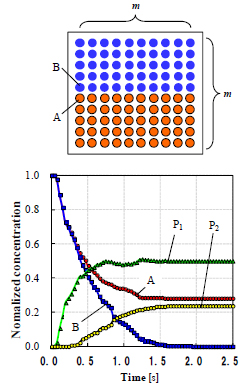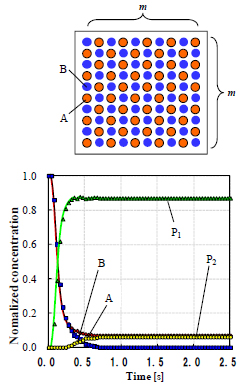Yield Prediction Method of a Reaction in a Micro-Fluid Device and Experimental Proof of Increased Production using Parallel-Connected Devices
 |
 |
 |
Shigenori TOGASHI, Yukako ASANO and Yoshishige ENDO *1 Hitachi, Ltd., Hitachi Research Laboratory, |
||
Abstract
Micromachining technologies have recently been applied to designing miniaturized devices for synthetic applications, i.e., micro-fluid devices(1) (2). The potential advantages of using a micro-fluid device, rather than a conventional reactor, include better control of reaction conditions, improved safety, and improved yield. Improved yield has been reported in the following reactions: the Friedel-Crafts monoalkylation reaction (3), Sonogashira coupling reaction (4), etc. Even the production scale has been touched upon; some of the first examples to be released were polymerization (5) and nitroglycerin (6) using parallel-connected devices. However, most past researches focused mainly on the experimental results. Moreover, the production scale was relatively small, and the number of stacked micro-fluid devices was not very large. Accordingly, the objectives of the present study are to predict the yield of chemical reactions when a micro-fluid device is used and to develop a micro-fluid system using the parallel-connected of 20 micro-fluid devices that can increase the production scale.
To predict the conditions for improving chemical reaction yield in a micro-fluid device, the relationship between chemical reaction and molecular mixing was analyzed by Monte Carlo simulation. The targeted chemical reaction in the micro-fluid device is the consecutive reaction, where A and B are reactants, P1 is the main product, P2 is the by-product, k1 is the reaction-rate constant of the first stage, and k2 is the reaction-rate constant of the second stage. Figure 1 shows the results of Monte Calro simulation. In case of (b) complex mixture at the initial condition, the yields of the main product P1 is improved compared with (a) complex mixture at the initial condition. The non-dimensional Damkohler number Da is defined as the ratio of a chemical reaction time to a molecular mixing time. Figure 2 shows the relationship between the Damkohler number Da and the reaction yield of main product P1. It was found that the reaction yield of main product was improved by using a micro-fluid device when the ratio of the reaction rate constants is k1/ k2 >1.
To validate the Monte Carlo simulation results described above, the validation experiments of four kinds of consecutive reactions were conducted using both the micro-fluid device and the conventional batch method. Figure 3 shows the channel structure and configuration of the micro-fluid device using the validation experiments. The experimental results were plotted as symbols in Fig.2. It was found that the experimental results were good agreement with the predicted results by Monte Carlo simulation.
Next, the micro-fluid system of 20 parallel-connected micro-fluid devices was developed as shown in Fig.4. The maximum flow rate of the micro-fluid system was 10 mm3/s, which corresponds to 315 t/year. Evaluation of the chemical performance of the micro-fluid system was conducted using a nitration reaction. It was found that the micro-fluid system increased the production scale without decreasing the yield of the products.
Keywords
Microfluidics, Mixing, Diffusion, Numerical Simulation, Chemical Engineering Equipment
 |
 |
| (a) Two layers | (b) Complete mixture |
| Fig. 1 Results of Monte Calro simulation | |

Fig. 2 Relationship between the Damkohler number Da and the reaction yield Y1 of main product P1

Fig. 3 Channel structure and configuration of a micro-fluid device

Fig. 4 Structure of parallel-connected micro-fluid devices
References

